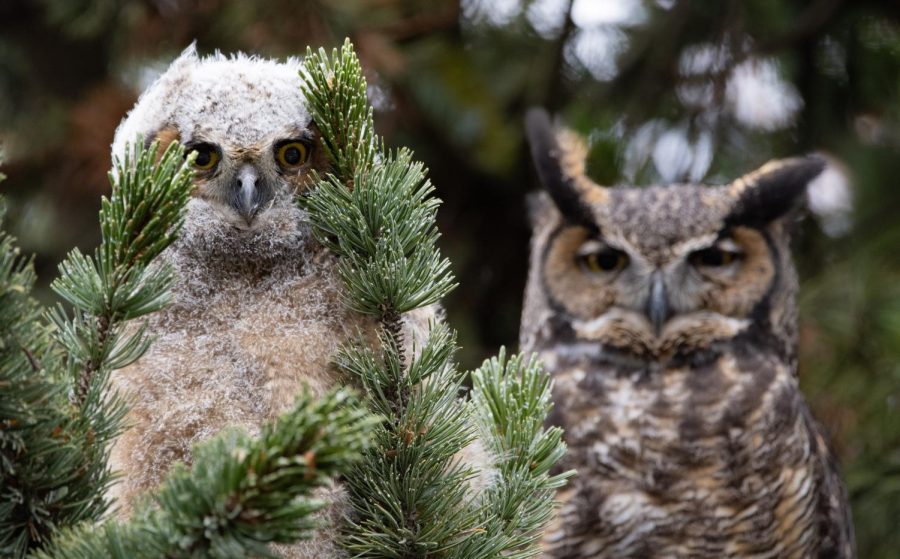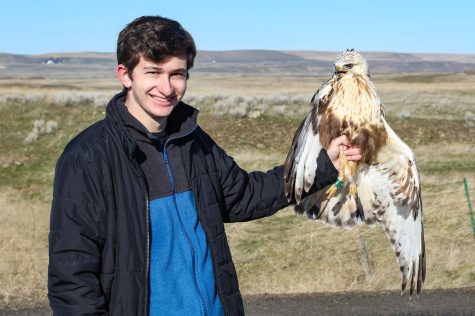Owls well that ends well
A family of Great Horned Owls chose to raise their young outside Bustad Hall
An adult and young Great Horned Owl sit in a tree outside Bustad Hall, March 30, Pullman, Wash.
April 27, 2023
In the cool of the evening, as students return to their dorms and campus quiets down, a family of local residents gets ready to start their day: The Great Horned Owls. These birds are found throughout the Palouse and, this year, at least one pair chose campus as the place to raise their young.
The parents-to-be went mostly unnoticed when laying their eggs and hatching their young in the Smith Center for Undergraduate Education parking garage. However, many more eyes were on them once they moved across the road with their recently-fledged youngsters to Bustad Hall.
The owls decided to settle down in a set of trees next to one of the hall’s entrances, immediately causing building employees to worry. Out of fear the owls would be bothered or harassed by students passing by, College of Veterinary Medicine employees quarantined off the newly-chosen owl home with caution tape and signs that warned people to respectfully stay back.

Caution tape and signs set up around the owls, March 30, Pullman, Wash.
While it is unclear whether people consistently followed this request, it quickly became evident the baby owls could not read, nor could they understand what caution tape was, as they often wandered into different trees at night and were found all over the surrounding area, often in different spots each day.
When the fledglings are still young, they cannot yet fly, but they are great climbers, said Kelly Cassidy, WSU Conner Museum curator. This means they often wander around at night, climbing up into different trees before sunrise. The parents, of course, are forced to follow their young wherever they choose to go to keep them safe.
This regular movement obviously exposed the owlets to much more of busy campus life: talkative students, swift and silent eBikes and the seemingly never-ending flow of traffic. However, Cassidy did not believe there was much of a cause for alarm — at least, not because of the students.
“Their biggest dangers are probably windows and vehicles,” Cassidy said. “The vegetation for mice tends to be in a strip along the road, which makes them more likely to interact with cars.”
Cassidy also believes constant exposure to students desensitizes the owls to people, so they are not perceived as much of a threat and do not bother the birds as much.
This desensitization has likely been going on for generations. While it is hard to say how long Great Horned Owls have bred on WSU’s Pullman campus, they have been around since at least the 1990s, Cassidy said.
However, Cassidy said she believes the owls have likely been breeding on campus from the day it was built.

A young Great Horned Owl sits alone in a tree outside Bustad Hall, March 30, Pullman, Wash.
WSU alum RJ Baltierra has witnessed some of this long-term breeding firsthand. While attending classes in Pullman from 2014 to 2018, Baltierra said he consistently saw the same owls nesting on campus: a pair nesting on the outskirts of campus and a pair nesting in the heart of Southside.
“Sometimes they were nesting in high-traffic areas, but sometimes they weren’t,” Baltierra said. However, Baltierra said he never saw anyone disturb the owls, and that they would often go completely unnoticed unless he incidentally drew attention to them by stopping to watch.
Baltierra said the owls’ presence on campus and their early nesting time — laying eggs during cold, snowy February despite the conditions — may be due to heat from the campus’ buildings and heated walkways.
“Because the sidewalks and buildings are heated, I bet that keeps the small mammals active,” said Baltierra. “It keeps their prey base going when they’re not normally around.”
For whatever reason the owls chose the location, it no longer matters, as the whole family has recently vanished altogether. Now that the young owls can likely fly, Cassidy said, they could be anywhere.
“They could just be out of sight somewhere close, but Great Horned Owls are pretty well camouflaged — it’s hard to say,” Cassidy said.
For now, all that can be done is hope the fledglings made it to adulthood safely and await the parents’ return to breed on campus next year.


















